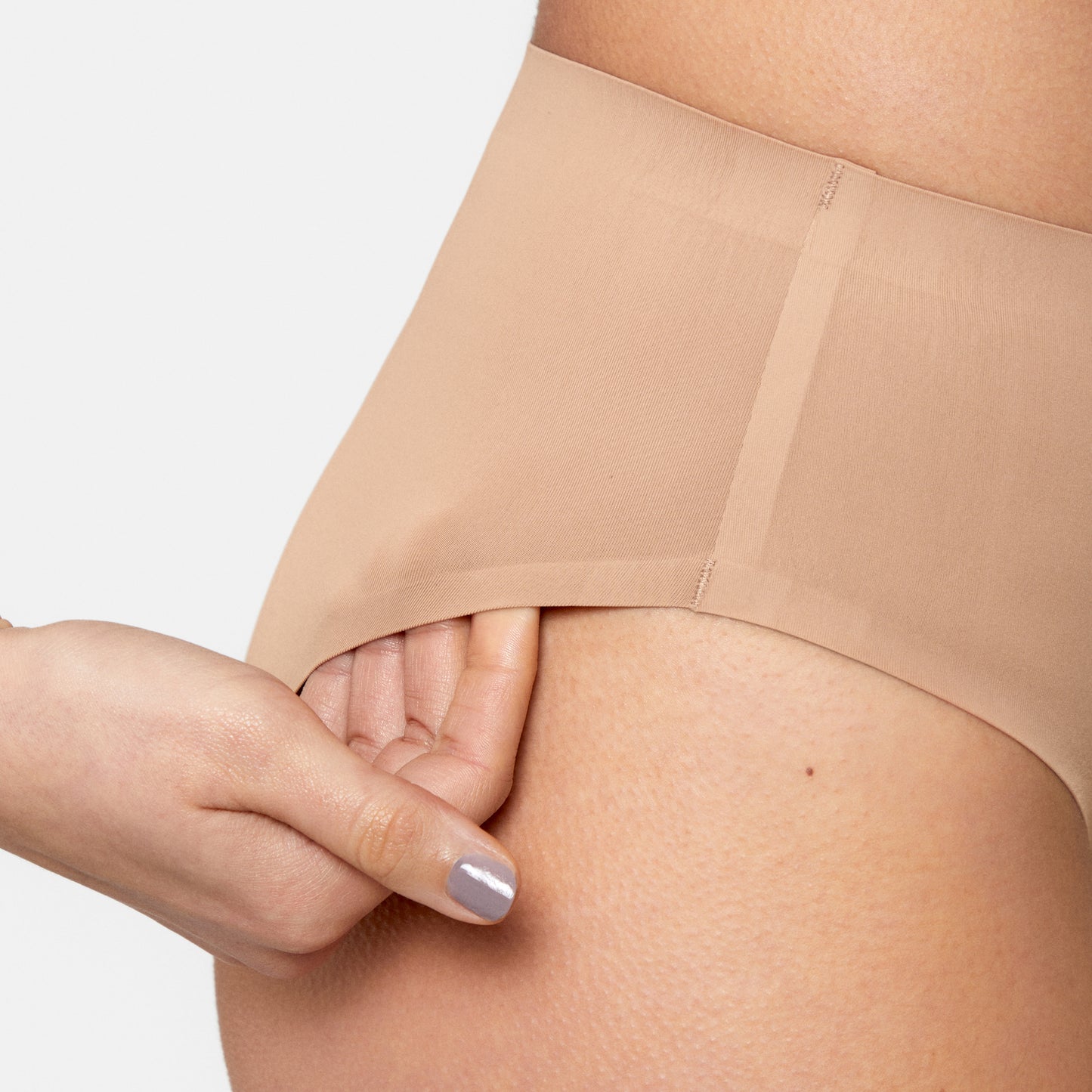Menstruation: How does the menstrual cycle work?
When it comes to the topic of menstruation and the menstrual cycle, many people still have big question marks in their eyes. And yet, the female cycle and menstruation are the most natural things in the world.
What do you know about your cycle? Which hormones play a role and change throughout your monthly cycle, and what menstrual symptoms do you struggle with? It's high time to list the absolute must-knows!
How long does the cycle usually last?
In general, a healthy female cycle is assumed to be 28 days long and has ovulation in the middle of the cycle. However, this standard cycle applies to only 4% (!) of women.
The vast majority of women have significantly longer or shorter cycles, and ovulation does not occur in the middle of the cycle.
Each menstruating person has their own cycle, which can vary greatly: not only does the cycle length vary, but the cycles can also fluctuate significantly among individuals.
Your cycle can be influenced by many factors: stress, exercise, exertion, fatigue, psychological and emotional stress, as well as various medical conditions can all play a role. Often, there may also be spotting or intermenstrual bleeding at different times in your cycle. So, if your cycle deviates from the norm, it doesn't mean that something is wrong.
What are the phases of the menstrual cycle?
The female cycle begins on the first day of menstruation and ends on the day before the onset of the next bleeding. It is divided into four phases:
- Menstruation
- Follicular phase
- Ovulation
- Luteal phase
Many menstruating individuals are familiar with the ups and downs of their mood during a cycle. This is completely normal. The reason for this is the sex hormones that flood our bodies in a wave-like pattern. The following hormones play a crucial role in the female cycle:
- Follicle-stimulating hormone (FSH)
- Luteinizing hormone (LH)
- Estrogen
- Progesterone
Menstruation: The period
A new cycle begins on the first day of the period. The initiator of the bleeding is the periodic shedding of the uterine lining, which is triggered by a drop in the hormones estrogen and progesterone. Since no fertilized egg has implanted in the previous cycle, the lining of the uterus detaches.
All four hormones that influence the cycle (FSH, LH, estrogen, and progesterone) are at a low point during this time. Menstrual bleeding varies in intensity and duration among women.
Just like the entire cycle, our period is influenced by various factors. You can do several things to support yourself and your body during this phase, such as avoiding stress. Your diet during your period can also affect your hormone levels and thus your cycle and monthly bleeding.
Four out of ten women experience abdominal cramps or premenstrual syndrome (PMS) during their period. These menstrual pains can be quite intense: according to British Professor John Guillebaud from University College London, the level of pain women endure during menstrual cramps is comparable to the pain experienced during a heart attack! In other words, it's not an exaggeration when a woman complains about cramps during her period, and the symptoms should not be dismissed with a shrug. Several recent studies have shown that acupuncture is effective in treating menstrual pain and reducing it.
What can help with severe period pain: period underwear! With our femtis period panties, you don't have to insert anything into your vagina and you don't have to deal with sticky pads or blood stains. Simply put on the panty and feel comfortable. Especially individuals with endometriosis suffer from very severe pain, which is why we have developed underwear for endometriosis specifically designed to meet their special needs. Depending on the heaviness of your flow and the amount of blood you lose, you can choose from different absorbency levels with femtis. Many women report that their menstrual pain becomes easier with menstrual underwear.
Did you know that menstruation is considered impure in many places? According to this belief, for example, menstruating individuals in Nepal have to live in separate huts during their period. They are not allowed to have contact or touch non-menstruating males, as they could become ill.
Follicular phase: Egg maturation
In this phase, also called the proliferation phase, our brain releases an increased amount of follicle-stimulating hormone (FSH). This hormone stimulates the maturation of about 40 to 100 egg follicles in our ovaries. The egg follicles produce estrogens, specifically the female sex hormone estradiol. Typically, only one of the egg follicles in the ovary develops into a mature follicle ready for ovulation. The others usually regress, unless there is a hormonal disorder such as polycystic ovary syndrome (PCOS).
Ovulation Phase: Ovulation
Estrogen levels rise in the body, and luteinizing hormone (LH) is released. Together with progesterone, it triggers ovulation. The mature egg is transported into the fallopian tube and travels towards the uterus. During ovulation, the cervix opens slightly, and cervical mucus becomes thinner. If fertilization does not occur within 24 hours after the release of the egg, it disintegrates and is expelled with menstruation approximately two weeks later.
During the ovulation phase, more cervical mucus (also known as discharge) is produced, which is whitish or slightly yellowish and feels creamier than in other phases of the cycle. The vaginal fluid can be used to determine the health of your vaginal flora.
Our specially designed femtis Everyday Discharge Underwear is here for you when there is more discharge in your panties during ovulation than usual.
Did you know that you can also experience anovulation? This is a cycle in which no ovulation occurs in the ovaries, but you still get your period.
Luteal Phase: Uterine Preparation
This phase is also known as the secretory phase. The follicle, the former shell of the egg, develops into the corpus luteum. Under the influence of LH, it produces the hormone progesterone. This hormone leads to the restructuring of the uterine lining in order to accommodate a fertilized egg. The blood flow to the uterine lining is increased by the formation of blood vessels, and mucus glands and supporting tissue structures build a "nest" for an egg fertilized by sperm. The cervical canal narrows after ovulation, and the cervical mucus becomes thicker. The progesterone hormone leads to a slight increase in body temperature.
If pregnancy occurs, the so-called placenta, also known as the "afterbirth," begins to grow and produces hormones that are important for maintaining the pregnancy.
Did you know that decidualization is a process that occurs during the secretory phase, where stromal cells transform into decidual cells under the influence of progesterone? This happens during pregnancy.
We find it more than impressive what female bodies accomplish every month and how the menstrual cycle with its four phases functions. No matter where you are in your cycle or which half of the cycle you are currently in, we are proud to accompany you.
What hygiene products are available for menstruation?
There are various menstrual products, and you should decide based on your individual needs which product is suitable for you during your menstrual flow. For many disposable products, there are also sustainable alternatives. Here is a brief overview of the four most common methods and their advantages and disadvantages.
The most well-known disposable products are pads and tampons. A pad is an absorbent liner that you simply stick to your underwear. They are easy to use, widely available, and come in various absorbency levels. However, pads often contain a lot of plastic and can sometimes cause skin irritations and friction.
A tampon is an elongated cotton wad that is inserted into the vagina to absorb the blood, making it virtually invisible. Tampons are also widely available and suitable for all activities, including swimming. However, it requires some practice to insert a tampon, and it should be changed regularly to prevent the growth of bacteria in the body, as this can, in extreme cases, lead to toxic shock syndrome (TSS).
The sustainable alternatives to these hygiene products are period underwear and menstrual cups. Period panties are underwear with an integrated absorbent insert that collects your menstrual flow and prevents the blood from your period days from leaking out. After wearing them, they are washed and reused. Period panties are available in different absorbency levels and styles, so you can find the right panty for your individual needs. They are suitable for all menstruating individuals and are easy to use, comfortable, and stylish, just like your favorite underwear. They are especially useful during the first period, known as menarche, as young girls may prefer not to insert anything.
If you're looking for an alternative to tampons, a menstrual cup is the right choice for you. A period cup is a small, flexible silicone cup that is inserted to collect the blood inside your body, making it invisible like a tampon and suitable for all activities, including swimming.
How can I calculate my menstrual cycle?
There are various methods to track your cycle. You can use your calendar as a cycle tracker, observe your vaginal discharge, measure your basal temperature or body temperature upon waking up, or use specific apps to calculate your cycle. These methods can provide valuable insights into your different cycle phases and your specific needs during each phase. You can also calculate your ovulation and determine your fertile days, increasing the chances of pregnancy or avoiding unwanted pregnancy.
If your cycle is not balanced, it can lead to menstrual cycle disorders. You may have polymenorrhea, which is a too frequent menstruation with a cycle length of fewer than 21 days. Oligomenorrhea refers to a too infrequent menstruation with a cycle length of 35 to at least 45 days and up to 90 days until the next period. These irregularities can indicate health issues and should be discussed with your gynecologist.
Woman's cycle throughout life
Your cycle changes throughout your life, depending on the life stage you are in. The first time your cycle becomes visible to you as a girl is likely with your first period. This first menstrual flow and thus your first cycle are a very special experience. It comes with various physical and emotional changes. Especially during this time, it is crucial to create support and an open atmosphere to break the taboo around the topic so that open conversations can take place. It helps to understand that menstruation is something entirely natural and to develop a positive connection to it. In fact, it is something good because it indicates that your body is doing well. If your period is absent or the intervals between bleeding are highly irregular, it often indicates an imbalance. Your body is no longer in equilibrium, and you often notice it through your cycle.
During pregnancy, your hormones and cycle also undergo changes. If an egg is successfully fertilized and travels down the fallopian tube, there is no menstruation. The most significant hormonal changes occur during the first trimester. Your estrogen and progesterone levels rise significantly. Progesterone is responsible for thickening the uterine lining, creating an environment for the egg to implant.
After childbirth, menstruation usually resumes within the first three months, earliest after four weeks. This varies individually and depends on whether you are breastfeeding. For more than half of non-breastfeeding women, it occurs within the first six to twelve weeks.
The last change in the female cycle takes place during the menopause. It begins about 4 years before the last menstruation with the premenopause. Hormone production decreases and ovulation occurs less frequently, which can lead to periods that are unbalanced, very long or very short, very heavy or very light. In the perimenopause, the irregularities increase and bleeding may stop altogether. With the menopause, menstruation stops, which occurs on average at the age of 51. It occurs after the last ovulation and no more eggs can mature.


